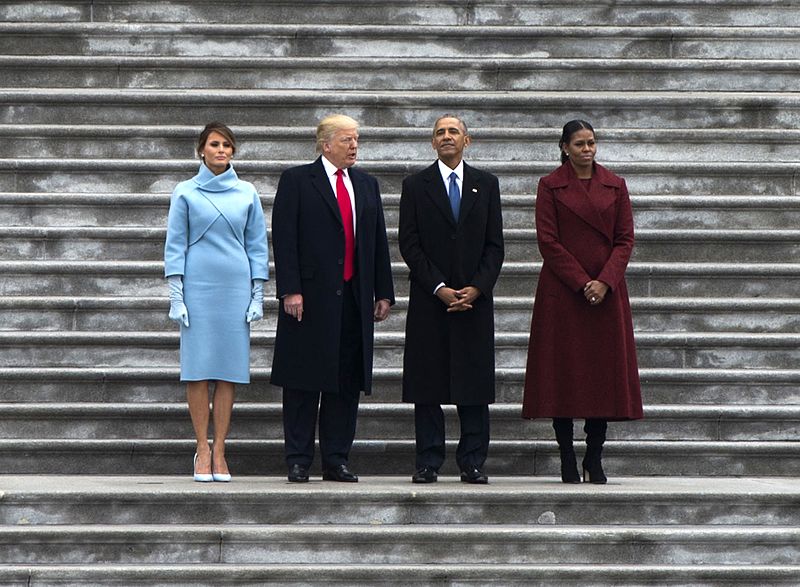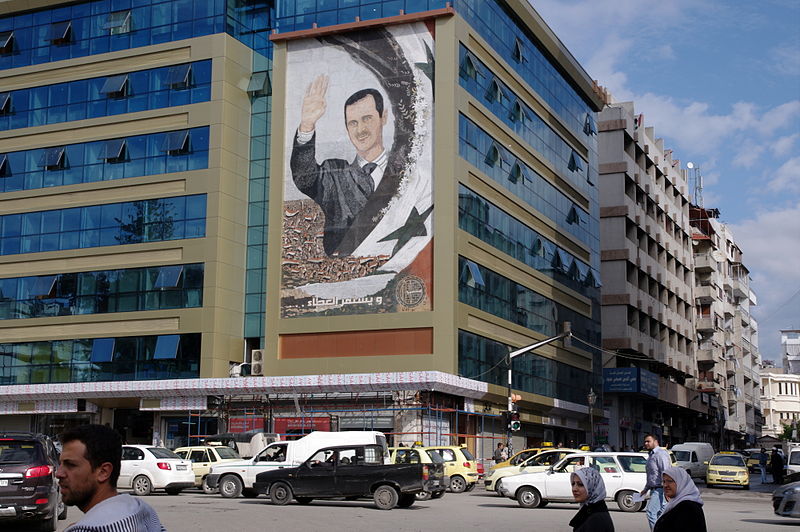Pax et Bellum | Americas, Analysis, Aron Woonink, Civil Wars, International Politics, Middle East and North Africa, Opinions |
Many jars of ink have been spilt on Donald Trump’s election last month. Every spectator, whether they’re journalists, policymakers or ordinary citizens, wonders what this remarkable figure’s victory will mean for the US and the rest of the world. Will Muslims be banned from entering the US? Will he start a trade war with China? Will he build the wall? And will the Mexicans pay for it? Given the fact that most of Trump’s ideas and plans are born out of downright ignorance or even pure insanity, one would expect that his views on the situation in the already unstable and war-torn Middle East are disastrous. But are they? This article will make an attempt to discover the central themes in Trump’s policy towards the situation in Syria, how this is received in the region itself, and based on this, what options there are left for the future.
Although Trump’s credo of “America-First” may have an egocentric and ignorant connotation, there is more to it than just putting US interests on number one of the list of priorities. Trump seems to be a big opponent of regime change abroad, which is reflected in his two most central views on the war in Syria: the US should get out of there and refrain from destabilizing Middle Eastern countries, while cooperating with Vladimir Putin’s Russia to “knock the hell out of” the Islamic State (IS). Additionally, Trump seems to have a peculiar preference for what he calls “strong leaders”. This may be a sign of potential cooperation with, aside from Putin, Egypt’s al-Sisi, Turkey’s Erdogan or even Syria’s Assad (Khouri, 2016).
This is a clear policy shift: Trump plans to end the past decade’s sponsoring of pro-democratic movements and regime change in the Middle East, by replacing it with the approach of favoring “stability” under authoritarian leaders. He is also clearly planning to refrain from criticizing those regimes for violating their population’s human rights, again for the sake of not destabilizing them. Trumps envisioned policy shift is also illustrated by his view on NATO, pressing for the other member countries to contribute more financially if they want to enjoy the US’s protection (Khouri, 2016).
This shift, in turn, also has serious consequences for the wars that are being fought right now, as the conflict in Syria can be seen as one originating in a “strong leader of a stable country” versus a “democratic movement”, in which the US sided with the latter. After January, the US, as Trump hinted to in an interview in October, might not push for Assad’s removal as fanatically as they did before, instead prioritizing the defeat of IS above all (Reuters, 2016). This would then entail a halt in US-support for the moderate Free Syrian Army groups, the mostly non-radical opposition to the Assad regime (Lister, 2016).
Moving away from the macro-perspective, Foreign Policy-contributor and former NOS Middle East-correspondent Harald Doornbos explored how people in the region itself reacted to Trump’s victory. In a somewhat simplistic but yet interesting Twitter waterfall, Doornbos argues that the Middle East, Syria in particular, has for many years been the stage of an “epic battle” between followers of what he calls “the flag” and “the book”. With flag, he refers to Arabs, or Syrians in this case, who believe in the contemporary nation-state: a country with borders, a flag, and, in varying degrees, equality for all citizens (not to be confused with pan-Arabism/Arab nationalism). Supporters of the book argue that the Quran and Sharia should be the basis of society, not nationality (Doornbos, 2016). Although this is only one, simplified way of looking at the complex Syrian conflict (e.g. one could also see it as a conflict between Saudi Arabia and Iran), it still offers some interesting insights.

VOA News (Scott Bobb), FSA rebels cleaning their AK47s in Aleppo, Syria during the civil war (19 October 2012)
The adherents of the flag are furious that the West (supported by Turkey and the Gulf states) started favoring regime change during the Arab uprisings that broke out in 2011. In other words: using the promotion of democracy as an excuse, these countries contributed to the toppling of hostile secular regimes. This, in the end, resulted in chaos and war, rather than real democratic reform across the region. Syria is in this case perhaps the most striking example. The uprisings of 2011 provided the perfect opportunity for the West to end the reign of pro-Iran, pro-Hezbollah, pro-Russia and anti-Israel secular dictator Assad, but instead of marveling at a democratic Syrian state, we can now see the horrible situation the country has degraded to on the news every day (Ibid).
As the rebels realized they couldn’t win the fight against Assad by themselves, they started accepting foreign fighters and Western material support. This exacerbated the conflict even more, and Assad’s position weakened due to the growing capabilities of the opposing forces. Doornbos makes the comparison with the US-support for the mujahedeen in Afghanistan in the US’s proxy war against the Soviet Union (1979-1989), arguing that the Syrian opposition is today’s mujahedeen, with the same struggle between the two Cold War-powers in the background. Although it seemed at one point that the West was on the path to victory like it was in Afghanistan, the dynamics changed when Russia began to strongly support Assad from around the end of 2015 (Ibid).
This is where Trump enters the story. Doornbos argues that the nationalists, or the people of the flag, have never forgiven the West for supporting jihadists. Especially Hillary Clinton, Trumps adversary in the elections, is seen as the architect behind the Syrian regime change, support for jihadists and the war in general. Therefore, according to Doornbos, many nationalists completely agree with Trump’s envisioned policy of abandoning regime change, creating the “weird situation” in which secular, progressive Syrians support someone like Trump for these ideas, whereas the conservative Islamists would have preferred Clinton for her pro-regime change ideas. Although these are broad generalizations (there are examples of contrasting views as well), Doornbos seems to have observed that many Syrian nationalists were happy with Trumps victory (Ibid).

From the perspective of those in power in the Middle East, an interesting paradox can be distinguished. Although Barack Obama promised to improve relations between the US and the Middle East after being elected President; and Trump has been highly critical of Muslims (e.g. his proposed ban on people from Muslim countries entering the US), many Arab leaders feel relieved that Obama is finally leaving office, while they’re somewhat hopeful of Trump’s attempts to improve relations with the US’s Arab allies. Obama’s Middle Eastern strategy turned out to be in total incongruence with the views of his Arab colleagues: he pushed for the Iran-deal that Arab leaders opposed; and he limited US military involvement in Syria, that his counterparts advocated. Therefore, Arab leaders hope that Trump will synchronize US foreign policy more with them than Obama did, even though they don’t like his rhetoric (Ghitis, 2016).
There are, of course, a lot of notes to be made about this expected shift in US foreign policy. For example, Trump has to confront a fundamental contradiction in, on the one hand, his attempt to support Assad (which would make Iran happy) and on the other hand, reopening talks about the Iranian nuclear deal. Also, he wants to build on the relationships the US has with most Gulf States, Jordan and Turkey, who want to get rid of Assad, while it’s part of his plan to keep Assad in power (Khouri, 2016; Lister, 2016). Additionally, a joint US-Russian strategy towards IS using the military tactic of carpet bombing is very likely to lead to an even greater breeding ground for future terrorists, making the strategy a likely short-term success, but a long-term danger. Moreover, it can exacerbate the refugee crisis we are currently witnesses of due to the conflict in Syria, in Europe but even more so in the region itself (Lister, 2016). Finally, Trump seems to support the Kurdish cause, both in terms of increasing the aid the US provides them with, and a possible Kurdish state (Al-Qaher, 2016).
Considering all of this, what does the region’s future look like? It is very difficult, if not impossible, to make any predictions for how the conflict will develop. The question is also: what is “good” for Syria? What should we be satisfied with? Would we accept the reintroduction of authoritarian stability under Assad, if this leads to less people getting killed? Is this even possible? Given the almost non-existent success of negotiated settlement in the Syrian case, would this be a fruitful strategy for Trump to pursue? If Trump and Putin can get along in the way they say they will, perhaps, though unlikely, they can manage to broker some sort of agreement without a lot of bloodshed. Support for Assad, on the other hand, will most likely crush the genuine democratic movement in Syria, keep a dictator in place and probably lead to many casualties as well. Doing nothing is also not an option; people are still dying in Syria every day, IS isn’t losing ground fast enough and, looking ahead, there is not even a single ray of light at the end of this tunnel. Now that Aleppo, after a large-scale humanitarian tragedy, will most likely be recaptured by Assad’s forces, Trump will be presented with a totally different situation than his predecessor, making it even less clear what the right path forward would be (Bernstein, 2016).
We will have to wait and see what Trump’s foreign policy will look like. Will he indeed abandon Obama’s policy of regime change and promotion of democracy, and instead favor an approach of cooperating with ruthless authoritarian dictators in an environment of relative stability? His words in the campaign seem to suggest he will. However, talk does not equal action, as Obama’s words directly after his election and his subsequent presidency demonstrate, as was mentioned earlier. In his discourse, Trump seems hostile towards Muslims, but in practice, no one knows what an erratic person like him will actually do. One of the first signs, namely his nomination of ExxonMobil president and CEO Rex Tillerson, who has good relations with Russia (New York Times, 2016), as Secretary of State, indicates that the aforementioned cooperation with Russia is indeed far from unrealistic. For us analysts, all we can do is sit tight and wait for Trump’s next, probably incalculable decisions.
Aron Woonink
Aron is a student at the Master Programme in Peace and Conflict Studies at Uppsala University.
The blog is run independently of the Department of Peace and Conflict Research in Uppsala. The Pax et Bellum Editorial Board oversees and approves the publication of all posts, but the content reflects the authors’ own perspectives and opinions.
REFERENCES
- Al-Qaher, Sarah (2016) Trump fever sweeps Iraqi Kurdistan. Last visited on: 17-12-2016. Available at: http://www.al-monitor.com/pulse/originals/2016/12/kurdistan-iraq-trump-usa-independance.html
- Bernstein, Leandra (2016) Trump’s Syria policy could be engagement or outsourcing to Russia, experts say. Last visited on: 17-12-2016. Available at: http://wjla.com/news/nation-world/trumps-syria-policy-could-be-engagement-or-outsourcing-to-russia-experts-say
- Doornbos, Harald (2016) De winst van Trump & het Midden-Oosten (Dutch). Last visited on: 17-12-2016. Available at: https://storify.com/AbdulwadudLouws/de-winst-van-trump-het-midden-oosten
- Ghitis, Frida (2016) Arab Rulers are Happy to See Obama Go, but Uncertain About Trump. Last visited on: 17-12-2016. Available at: http://www.worldpoliticsreview.com/articles/20569/arab-rulers-are-happy-to-see-obama-go-but-uncertain-about-trump
- Khouri, Rami G. (2016) What will Trump do on Syria? Trump’s “America First” is likely to make him cooperate with Putin on Syria. Last visited on: 17-12-2016. Available at: http://www.aljazeera.com/indepth/opinion/2016/11/trump-syria-policy-161110104850878.html
- Lister, Charles (2016) Trump’s Syria Strategy Would Be a Disaster. Last visited on: 17-12-2016. Available at: http://foreignpolicy.com/2016/11/17/trumps-syria-strategy-would-be-a-disaster/
- New York Times, the (2016) Rex Tillerson, Exxon C.E.O, Chosen as Secretary of State. Last visited on: 17-12-2016. Available at: http://www.nytimes.com/2016/12/12/us/politics/rex-tillerson-secretary-of-state-trump.html
- Reuters (2016) Exclusive: Trump says Clinton policy on Syria would lead to World War Three. Last visited on: 17-12-2016. Available at: http://www.reuters.com/article/us-usa-election-trump-exclusive-idUSKCN12P2PZ

